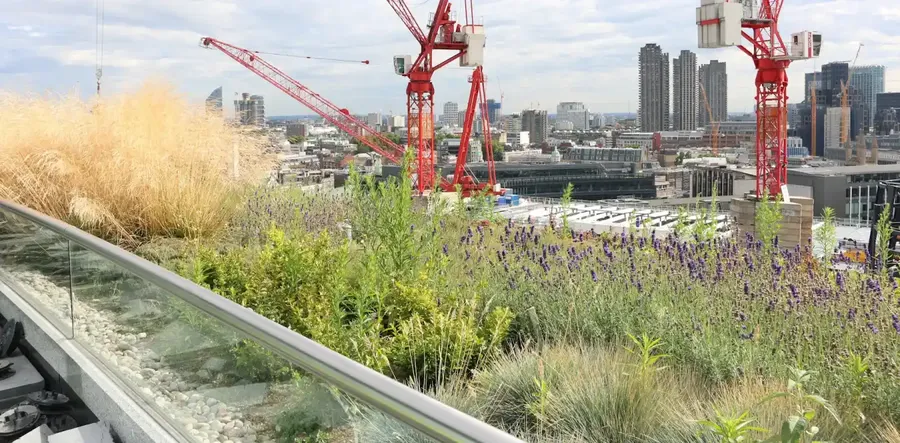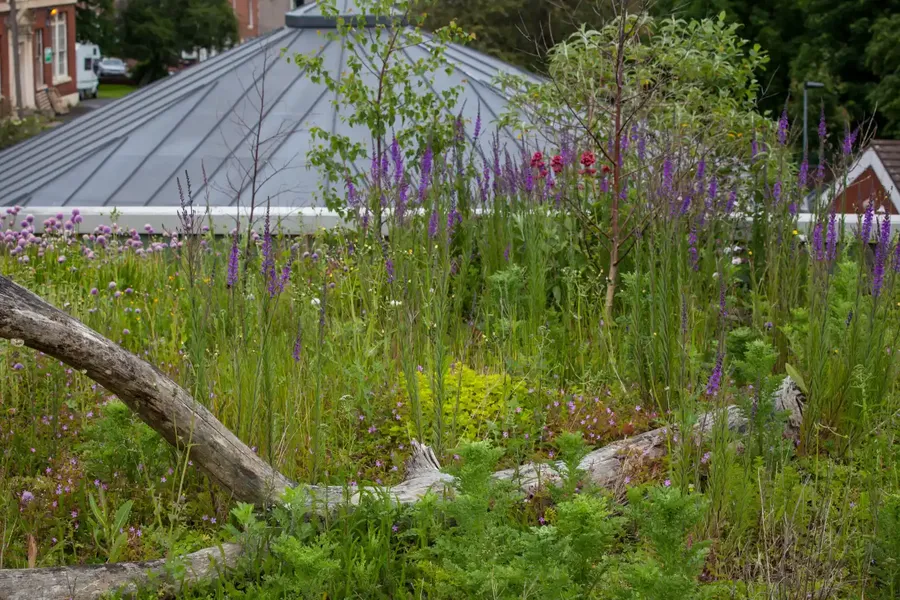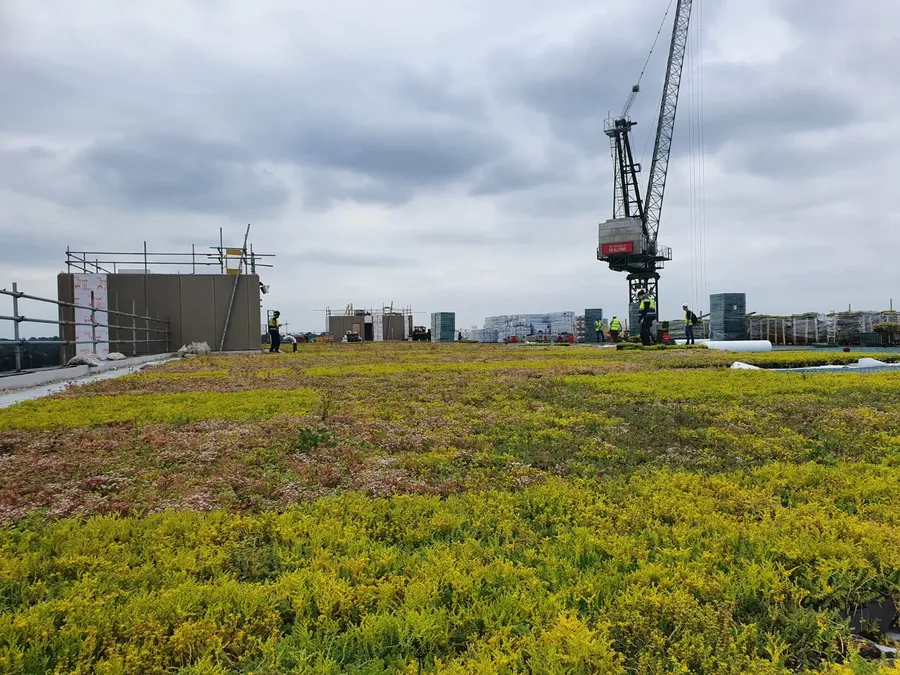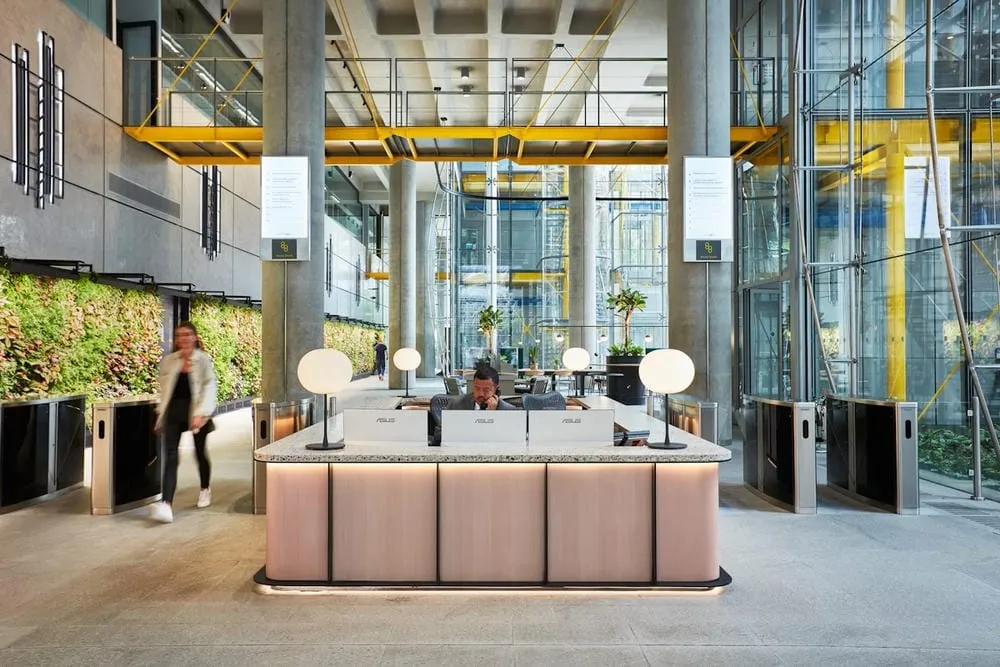Green Roof Advantages & Disadvantages

Green Roof Benefits: Environmental, Economic, and Social
Thinking about adding a green roof to your building or next project? You’re in good company. Across the UK and EU, more rooftops are turning green.
With new sustainability requirements shaping planning and development, green roofs (also called “living roofs”) offer a practical way to meet regulations, add property value, and set your building apart.
If you’re weighing the pros and cons of a green roof, here’s what to consider.
Environmental benefits of green roofs
A green roof changes more than the view from above. It turns an underused surface into an ecosystem, with benefits that stretch beyond the rooftop itself.
Improve air quality
A mix of healthy plants and soil in a living roof works like a natural filter. The power duo can:
- Absorb pollutants
- Trap particulates like dust
- Capture carbon dioxide
- Generate oxygen
The ultimate impact depends on the plants chosen (some have stronger air purification properties than others) and the volume of soil on your roof. Green infrastructure consultants can help you design the best scheme for the job.
Support biodiversity
In many cities, nature is squeezed into a few parks, while thousands of square metres up above sit empty. A biodiverse green roof changes that, creating habitats for wildlife such as pollinators, burrowing insects, birds, and bats.
Biodiversity Net Gain (BNG) is now part of many planning requirements, and meeting these standards comes down to design. Native wildflowers, pollinator-friendly plants, insect hotels, and beehives create micro-habitats that support a range of species.
See how a biodiverse green roof brought Deloitte's London HQ to life and helped the development achieve BREEAM Excellent: Read our case study.
Regulate temperatures, inside and outside
Soil and vegetation release moisture through evapotranspiration, which cools a green roof and the surrounding area. This helps counter the urban heat island effect, where cities are warmer than rural areas. Tests have shown up to a 15°C drop between vegetated and bare surfaces.
In the winter, that same layer acts as insulation, holding in warmth. The thermal advantages of green roofs in both summer and winter help reduce HVAC needs, making the building more energy efficient (and saving costs).
Manage rainwater and reduce flood risk
Rainwater runoff from traditional flat or pitched roofs can overwhelm drainage systems. A green roof absorbs and retains a significant amount of water, reducing pressure on urban drainage and helping to mitigate flooding.
For even greater capacity, consider a blue roof. This stores additional rainwater beneath the soil, managing stormwater and providing a supply that can be reused for irrigation.

Green roof advantages for your property
A green roof has to work for your business as well as the environment. Living roofs can improve a building’s performance, both immediately and over the long term.
Drive compliance and support sustainability goals
A green roof can play a key role in meeting planning. When designed well, it contributes towards:
- Biodiversity Net Gain (BNG) requirements
- Urban Greening Factor (UGF) scores
- Certifications such as BREEAM, WELL, or LEED
These standards recognise performance in areas like water management, energy efficiency, carbon footprint reduction, and habitat creation.
Enhance aesthetics and property value
A green roof transforms the appearance of a building, adding a natural layer that stands out among steel and concrete. For property owners, this boost in visual appeal can also mean increased marketability, customer spend, and potential resale value.
See how Viritopia’s green roof improved the view from the Hilton Hotel next to Victoria Way Car Park in Woking, UK: Read our living roof case study.

Provide protective cover
Vegetation and soil protect a roof from weather that can shorten its lifespan, such as:
- UV damage
- Acidic rain
- Freeze-thaw cycles that break down the roof membrane
By using a green or sedum roof solution (like the GrufeKit), you can increase the lifespan of a roof from 30 years to 40-50 years. You can also extend the service life of the waterproofing beneath.

Improve solar panel performance
Pairing a green roof with solar panels — known as a biosolar roof — can deliver additional value. The vegetation keeps the roof cooler, which in turn keeps photovoltaic panels operating at an optimal temperature. This combination can improve solar panel performance by 3.6%, according to a study.
Social benefits of living roofs
Alongside their environmental and property advantages, green roofs offer social value to the communities who live and work beneath them.
Support mental and physical health
The science of biophilia tells us that we’re drawn to nature and feel better around it. Roofs are the perfect opportunity to provide natural spaces for building occupants or the local community.
Access to nature has been shown to lower stress, improve concentration, and support recovery in healthcare settings. Even when a green roof isn’t accessible, views of greenery can lift mood and focus. In workplaces, these benefits can translate into improved productivity and fewer sick days.
Create spaces for community and connection
Intensive green roofs can be designed as social spaces for purposes like urban gardening or community events. In urban areas where ground-level space is limited, this extra layer of usable outdoor space can be a real asset.
Provide natural sound insulation
Plants offer natural acoustic benefits. Compared to hard surfaces where sound waves bounce off, plants break up the sound waves and soften the sound. Soil, leaves, branches, and woodier stems absorb sound, and plant leaves refract noise and eliminate echoes.
The deeper the substrate (soil), the greater the benefit. A green roof with a 120mm soil layer can reduce sound by 40dB, while 200mm of soil depth can reduce sound by 46-50dB.

Disadvantages of green roofs
Are there any cons to green roofs? While the pros are significant, there are a few practical considerations to keep in mind when deciding if a green roof is right for your building:
- Upfront cost: Materials, plants, and design work add to the initial investment compared to a conventional flat roof.
- Added structural load: The roof must be able to support the weight of the soil, plants, and water.
- Ongoing maintenance: Green roofs require regular care to stay healthy and compliant, which can add to operational costs.
- Not suitable for all structures: Some roofs may not be viable without adaptation. It’s important to know what your building can support.
- Installation complexity: Intensive green roof projects require specialised design and construction expertise to avoid issues like water leakage.
- Visual impact may be limited: With buildings where most people can’t see the rooftop, a green roof won’t make the same visual statement as a living wall that people can see from the ground.
- Not always the optimal solution: While green roofs contribute to BNG and UGF, they aren’t always the best way to maximise a plot’s potential. Living walls can offer greater benefit, with more planting area and visibility from street level.
Bring the advantages of a green roof to your building
The structural, social, and environmental benefits of green roofs make them a smart investment for both your property and the planet.
With over 20 years of experience in biophilic design, Viritopia’s green infrastructure consultants can help you select the right green solutions and design a scheme that maximises their impact.
Get tailored guidance
Ready to find out what a living roof or wall could do for your building? Get in touch with our team.
Explore more insights
Discover the latest in green infrastructure

Vanguard Logistics Park (Longmore) Featured in RIBA Commercial Directory 26

Green Roof Advantages & Disadvantages

Design with meaning: How office living walls reflect your brand

